Key Concepts
The occultation (obscuring) of one celestial body by another. Solar and lunar eclipses take place at syzygies of the Sun, Earth, and Moon, when the three bodies are in a line. At a solar eclipse, the Moon blocks the view of the Sun as seen from the Earth (Fig. 1). At a lunar eclipse, the Earth's shadow falls on the Moon, darkening it, and can be seen from wherever on Earth the Moon is above the horizon. See also: Earth; Moon; Sun; Syzygy
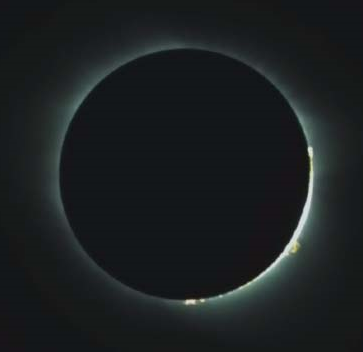
Eclipses of the Sun could be seen from other planets as their moons are interposed between the planets and the Sun, though their superposition is not as coincidental in angular size as it is for the Earth-Moon system. Eclipses of the moons of Jupiter are well known, occurring whenever the moons pass into Jupiter's shadow. An eclipse of the Sun visible from Uranus that occurred in 2006 was imaged by the Hubble Space Telescope. Certain binary stars are known to eclipse each other, and the eclipses can be followed by measuring the total light from the system. See also: Binary star; Eclipsing variable stars; Hubble Space Telescope; Jupiter
Related phenomena are transits, such as those of Mercury and Venus, which occur when these planets cross the face of the Sun as seen from Earth. They are much too small to hide the solar surface. Transits of the Earth will be seen from spacecraft. Occultations of stars by the Moon are commonly seen from Earth, and are studied to monitor the shape and path of the Moon; a solar eclipse is a special case of such an occultation. Occultations of stars by planets, dwarf planets, asteroids, and Kuiper-belt objects are now increasingly studied; the rings of Uranus were discovered from observations of such an occultation, and the atmospheres of Titan and Pluto are best known from occultation studies. Space missions, most notably NASA's Kepler mission, are discovering exoplanets by their transits across the faces of their parent stars. See also: Exoplanets; Mercury (planet); Occultation; Transit (astronomy); Uranus; Venus
Solar Eclipses
A solar eclipse can be understood as an occultation of the Sun by the Moon or, equivalently, the Moon's shadow crossing the Earth's surface. The darkest part of the shadow, from which the Sun is entirely hidden, is the umbra (Fig. 2). The outer part of the shadow, from which part of the Sun can be seen, is the penumbra.

Solar eclipses can be central, in which the Moon passes entirely onto the solar disk as seen from Earth, or partial, in which one part of the Sun always remains visible. Central eclipses can be total, in which case the Moon entirely covers the solar photosphere, making the corona visible for the period of totality, or annular, in which case the Moon's angular diameter is smaller than that of the Sun because of the positions of the Earth and Moon in their elliptical orbits. At an annular eclipse, a bright annulus of photospheric sunlight remains visible; it is normally thousands of times brighter than the corona, leaving the sky too blue for the corona to be seen.
The plane of the Moon's orbit is inclined by 5° to the plane of the Earth's orbit (the ecliptic), so the Moon's shadow commonly passes above or below the Earth each month at new moon. But two to five times each year, the Moon's shadow reaches the Earth, and a partial, annular, or total eclipse occurs. The Moon is approximately 400 times smaller than the Sun but is also approximately 400 times closer, so its angular diameter in the sky is about the same as the Sun's. Thus the Moon fits approximately exactly over the photosphere, making the phenomenon of a total eclipse especially beautiful. See also: Ecliptic
Phenomena
The partial phases of a total eclipse visible from the path of totality last over an hour. In the minute or two before totality, shadow bands—low-contrast bands of light and dark caused by irregularities in the Earth's upper atmosphere—may be seen to race across the landscape. As the Moon barely covers the Sun, photospheric light shines through valleys on the edge of the Moon, making dots of light—Baily's beads—that are very bright in contrast to the background. The last Baily's bead gleams so brightly that it appears as a jewel on a ring, with the band made of the corona; this appearance is known as the diamond-ring effect (Fig. 3). It usually lasts for 5–10 s, and in the clearest skies for as long as 40 s. See also: Atmosphere
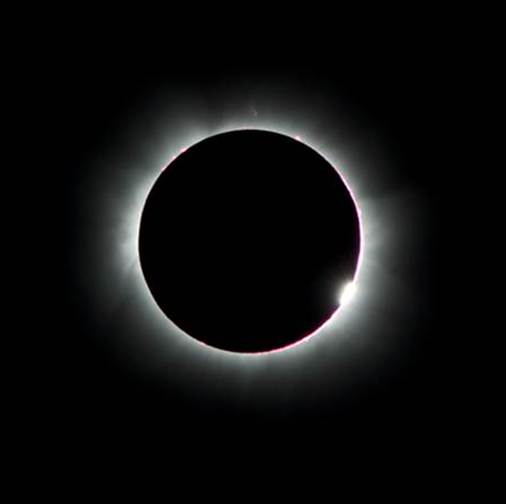
During the diamond-ring effect, the solar chromosphere becomes visible around the limb of the Moon, glowing pinkish because most of its radiation is in the form of emission lines of hydrogen, mostly the red hydrogen-alpha line. Its emission-line spectrum apparently flashes into view for a few seconds, and is called the flash spectrum. As the advancing limb of the Moon covers the chromosphere, the corona becomes fully visible (Fig. 4a). Its shape is governed by the solar magnetic field; common are equatorial streamers and polar tufts. At the maximum of the solar activity cycle, so many streamers exist that the corona appears round when it is seen in projection, as viewed from Earth. At the minimum of the solar activity cycle, only a few streamers exist so that the corona appears more elongated in projection. See also: Solar corona; Sun
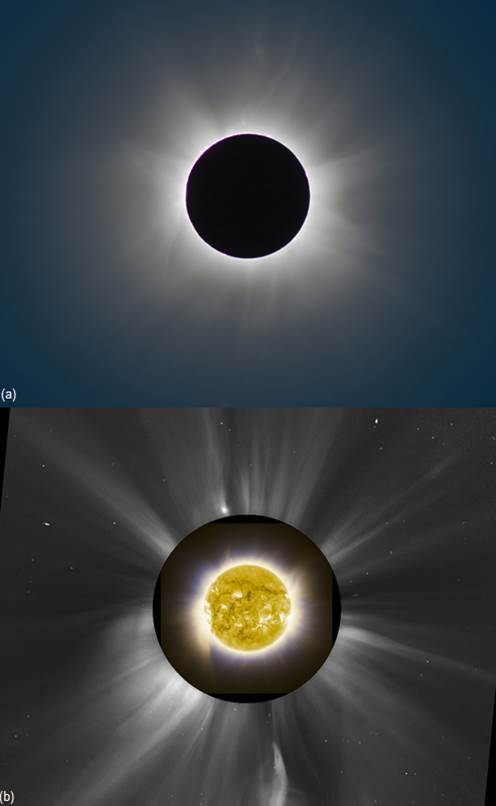
Totality (Fig. 5) lasts from an instant up through somewhat over 7 min, 30 s. At its end, the phenomena repeat in reverse order, including chromosphere, diamond ring, Baily's beads, shadow bands, and the partial phases.
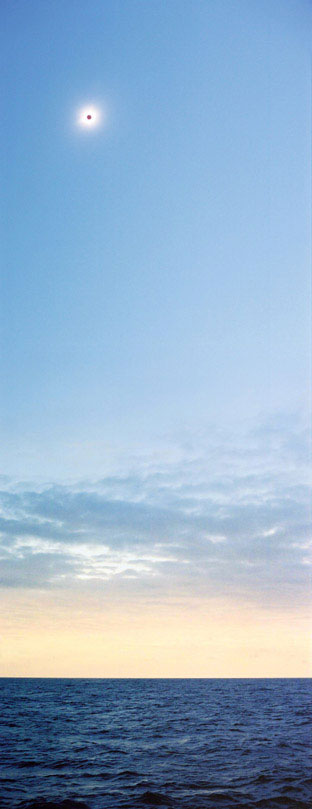
The corona is now monitored continuously in x-rays and in ultraviolet and visible light by orbiting spacecraft such as the Solar and Heliospheric Observatory (SOHO; ultraviolet and visible light), the GOES Solar X-ray Images, and, since 2010, the Solar Dynamics Observatory (SDO; ultraviolet). The spacecraft Hinode, a successor to the Yohkoh spacecraft, was launched in 2006 to continue such x-ray studies as well as visible-light and ultraviolet observations. Eclipse observations can provide ground truth for comparison with these missions on the days of eclipses and image parts of the corona that cannot be observed with spacecraft, whose coronagraphs must occult the lowest corona to limit scattering of light in the telescope systems. See also: Satellite (astronomy); Solar and Heliospheric Observatory
Positions and timing
The paths of the Sun and Moon in the sky intersect at two points, the ascending node and the descending node. Only when both the Sun and the Moon are near a node can an eclipse occur. Thus eclipse seasons take place each year, whenever the Sun is near enough to the node so that an eclipse is possible. Each eclipse season is 38 days long. Because the Sun's gravity causes the orientation of the Moon's elliptical orbit to change with an 18.6-year cycle, the nodes slide along the ecliptic and a cycle of two eclipse seasons—an eclipse year—has a period of 346.6 days, shorter than a solar year. See also: Moon
There must be at least one solar eclipse each eclipse season, so there are at least two each year. There may be as many as five solar eclipses in a calendar year (technically, a year), though most of these will be partial. Some of the partials will occur near the ends of the eclipse seasons, and it is also possible for there to be three eclipse seasons during a solar year. Adding lunar eclipses (including penumbral lunar eclipses, which may not be noticeable), there may be seven eclipses in a year.
Saros
An important coincidence relates lunar months and eclipse years. A total of 223 lunar months (technically, synodic months, the period of the phases) takes 6585.32 days. A total of 19 eclipse years—passages of the Sun through the same node of the Moon's orbit—takes 6585.78 days, and 242 nodical months—passages of the Moon through the node—take 6585.36 days. (Nodical months are also called draconic months, after the ancient Chinese dragon once thought to have been devouring the Sun at a solar eclipse.) Thus eclipses appear with this period of 18 years 111/3 days (plus or minus a day, depending on leap years), a period known as the saros. Further, 239 periods of the variation of distance of the Moon from the Earth, the anomalistic month, is 6585.54 days, so the relative angular sizes of the Sun and Moon are about the same at this interval. (The anomalistic month differs from the nodical and sidereal months because the orientation of the Moon's elliptical orbit drifts around in its orbital plane.)
As a result of the saros, almost identical eclipses recur every 18 years 111/3 days. The significance of the 1/3 day is that the Earth rotates one-third of the way around, and the eclipse path is shifted on the Earth's surface. Thus the June 30, 1973, 7-min eclipse in Africa was succeeded in a saros series by the July 11, 1991, eclipse in Hawaii, Mexico, and Central and South America, which reached maximum duration of 6 min 54 s in Mexico, and the 6 min 40 s eclipse of July 22, 2009, observed from China and the Pacific Ocean. After a saros, the Sun is slightly farther west than its original position, and the Moon is slightly north or south, depending on whether it is near an ascending or a descending node, so the eclipses in a saros drift from north to south or from south to north, starting near one pole and departing from the other. A complete series takes 1244–1514 years. The next solar eclipse with over 7 min of totality will be in a different saros, and will occur on June 25, 2150.
Motion over Earth's surface
The Moon's shadow travels at approximately 2100 mi/h (3400 km/h) through space. The Earth rotates in the same direction that the shadow is traveling; at the equator, the resulting motion of the Earth's surface makes up about 1040 mi/h (1670 km/h), making the speed of the eclipse across the Earth's surface 1060 mi/h (1730 km/h). When eclipses cross higher latitudes, the speed of motion associated with the Earth's rotation is not as high, so the eclipse speed is even higher. A supersonic Concorde (a test model, with windows cut into its top since the eclipse was high overhead) took advantage of an equatorial eclipse in 1973 to keep up with totality for 74 min. Ordinary jet aircraft cannot keep up with eclipses, so the term "eclipse chasing" is almost never accurate. See also: Aircraft
Scientific value
Even with advances in space technology, total solar eclipses are the best way of seeing the lower corona. Coronagraphs, telescopes for which special shielding and internal occulting allow observation of the corona from a few sites in the world on many of the days of the year, are limited to the innermost corona or to use of special filters or polarization. See also: Coronagraph; Solar corona
Coronagraphs have been sent into orbit, notably aboard Skylab, the Solar Maximum Mission, and SOHO, but limitations in spacecraft control lead to the necessity of overocculting the photosphere, cutting out the inner corona. For example, the coronagraph on Solar Maximum Mission occulted 1.75 times the solar diameter. The innermost coronagraph, no longer in operation, on SOHO's Large Angle Spectrographic Coronagraph (LASCO) over-occulted to 1.1 solar radii, and LASCO's two remaining coronagraphs image the Sun from 1.5 to over 30 solar radii. The coronagraphs on NASA's Solar Terrestrial Relations Observatory (STEREO) also over-occult. Other types of observations from space also apply to the corona, such as imaging x-ray observations. Further, any space observation is extremely expensive, over 100 times more for SOHO than for a given extensive eclipse expedition. So it is useful and necessary to carry out ground-based eclipse observations, ground-based coronagraph observations, and space-based observations to get the most complete picture of the Sun. Further, independent derivations of certain basic quantities must be carried out to provide trustworthy results; there have been cases in which data reduced from space observations had to be restudied because the need for different calibrations had shown up in eclipse work.
In Fig. 4b, a merger of an eclipse image and spacecraft images from SDO and SOHO shows how ground-based images during a total solar eclipse fill a doughnut-shaped region between the inner and outer spacecraft images that is not visible from Earth at other times. The central image from SDO shows the Sun's disk at temperatures around 2,000,000 K (2,000,000°C or 4,000,000°F) through a filter showing extreme ultraviolet radiation from highly ionized iron gas. The outer image, from SOHO, shows gas at the millions of degrees typical of the Sun's corona scattering photospheric light toward us, with one of LASCO's coronagraphs hiding the bright inner corona. Filling in the doughnut ring allows coronal streamers to be traced from their roots on the Sun's surface, through the eclipse corona, and into the solar wind, which is the expanding outer corona. See also: Solar wind
Related eclipse studies include use of the advancing edge of the Moon to provide high spatial resolution for radio observations of the Sun and, historically, of celestial radio sources. The atmospheric effects of the removal of incident sunlight from the Earth's atmosphere have also been studied at eclipses.
Historically, the test of the deflection of starlight carried out at the eclipse of 1919 and repeated in 1922 was the first verification of German-born U.S. theoretical physicist Albert Einstein's general theory of relativity. These results were restudied for the 1979 Einstein centennial, and their accuracy improved. The experiment is a very difficult one, and has been attempted at some eclipses, notably 1970 in Mexico and 1973 in Africa, without improving on the early results. But the effect has been verified to higher accuracy by studies in the radio part of the spectrum and by the observation of gravitational lenses, so optical eclipse tests are no longer necessary. See also: Gravitational lens; Relativity
Annular eclipses
Central eclipses in which the Moon is sufficiently far from the Earth that it does not cover the solar photosphere are annular. The Moon's umbra is about 374,000 ± 6400 km (232,000 ± 4000 mi) in length while the Moon's distance is 382,000 ± 25,000 km (237,000 ± 16,000 mi), so the umbra sometimes falls short of reaching the Earth's surface. Annular eclipses, like total eclipses, occur about every 18 months on average.
Since the corona is 1,000,000 times fainter than the photosphere, if even 1% of photosphere is showing the corona is overwhelmed by the blue sky and cannot be seen. So most annular eclipses are of limited scientific use.
The annular eclipse of 1984, visible from the southeastern United States, provided 99.8% coverage. The major scientific work carried out involved detailed timing of the Baily's beads in order to assess the size of the Sun. Such work has also been carried out at total eclipses. Some of the results, compared with solar diameters deduced from historical eclipse paths, seem to show a possible shrinking of the Sun by a measurable amount in a time of decades or centuries, which would lead to impossibly large effects on geological time scales; this has led to the suggestion that the Sun could be oscillating in size. But the question of whether any real effect is present has not been settled. The 1984 annular eclipse was so close to total that the corona could even be briefly seen and photographed, although no scientific studies of the corona were made. In the May 10, 1994, annular eclipse, widely viewed across the United States, only 94% of the Sun's diameter was covered, more typical of annular eclipses. The 1999 annular eclipse, whose path crossed Australia, provided 99% coverage, but since the Sun is about a million times brighter than the full moon, that still left about 10,000 times more light than on a moonlit night. The January 15, 2010, annular eclipse was viewed not only in visible light but also with the Giant Metre-wave Radio Telescope in India, to measure fine details in solar active regions as they were occulted by the Moon. The May 20, 2012 annular eclipse was similarly observed, because it was visible from large radio telescopes in California and from the National Radio Astronomy Observatory's Very Large Array in New Mexico. See also: Astronomical observatory; Radio astronomy; Telescope
The April 8, 2005, hybrid eclipse was annular at the ends of its path and total in the middle, over the Pacific Ocean, where the umbral cone reached the Earth's surface (Fig. 5).
Recent and future eclipses
Notable total eclipses in terms of duration and favorable weather were on June 21, 2001, in southern Africa; on December 4, 2002, in southern Africa and south Australia; and on March 29, 2006, in Africa, Turkey, and into Asia (Table 1; Fig. 6). More recent total solar eclipses were on August 1, 2008, in Siberia, Mongolia, and China; on July 22, 2009, in China; and on July 11, 2010, from the Cook Islands and atolls in French Polynesia, from Easter Island, and from southernmost South America. Major scientific expeditions carry out research on such occasions.
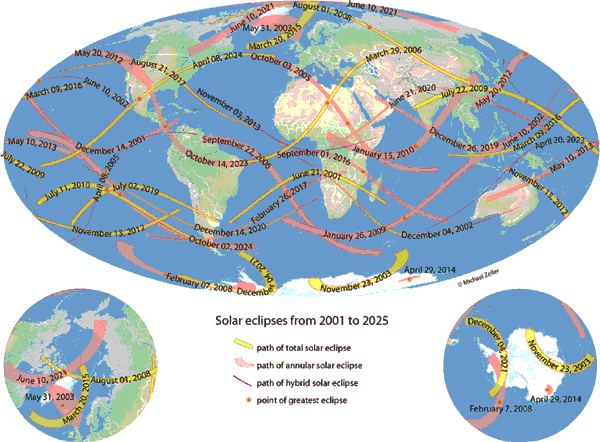
|
Calendar date |
Maximum duration of totality (min: s) |
Geographic region of visibility |
|---|---|---|
|
Apr. 8, 2005† |
0:42 |
Starts annular in western Pacific Ocean, becomes total in eastern Pacific, then becomes annular again for Costa Rica, Panama, Colombia, and Venezuela |
|
Mar. 29, 2006 |
4:07 |
Eastern Brazil, Atlantic Ocean, Ghana, Togo, Benin, Nigeria, Niger, Chad, Libya, Egypt, Turkey, Russia |
|
Aug. 1, 2008 |
2:27 |
Northern Canada, Greenland, Arctic Ocean, Russia, Mongolia, China |
|
July 22, 2009 |
6:39 |
India, Nepal, Bhutan, Burma, China, Pacific Ocean |
|
July 11, 2010 |
5:20 |
South Pacific Ocean, Easter Island, Chile, Argentina |
|
Nov. 13/14, 2012 |
4:02 |
Northeastern Australia, south Pacific Ocean |
|
Nov. 3, 2013† |
1:40 |
Annular only at beginning and end of path: Atlantic Ocean, Gabon, Congo, Zaire, Uganda, Kenya, then annular in Ethiopia |
|
Mar. 20, 2015 |
2:47 |
North Atlantic Ocean, Faeroe Islands, Arctic Ocean, Svalbard |
|
Mar. 9, 2016 |
4:10 |
Indonesia (Sumatra, Borneo, Sulawesi, Halmahera), Pacific Ocean |
|
Aug. 21, 2017 |
2:40 |
Pacific Ocean, United States (Oregon, Idaho, Wyoming, Nebraska, Missouri, Illinois, Kentucky, Tennessee, North Carolina, South Carolina), Atlantic Ocean |
|
July 2, 2019 |
4:33 |
South Pacific Ocean, Chile, Argentina |
|
Dec. 14, 2020 |
2:10 |
Pacific Ocean, Chile, Argentina, south Atlantic Ocean |
|
Dec. 4, 2021 |
1:55 |
Antarctica |
|
Apr. 20, 2023† |
1:16 |
Total except at beginning and end of path: South Indian Ocean, western Australia, Indonesia, Pacific Ocean |
|
Apr. 8, 2024 |
4:28 |
Pacific Ocean, Mexico, United States (Texas, Oklahoma, Arkansas, Missouri, Kentucky, Illinois, Indiana, Ohio, Pennsylvania, New York, Vermont, New Hampshire, Maine), southeastern Canada, Atlantic Ocean |
*Data courtesy of M. Littmann, K. Willcox, and F. Espenak, Totality—Eclipses of the Sun, 3d ed., Oxford University Press, 2008.
†These are hybrid or annular-total eclipses. They are total along the middle portions of their paths but annular at the ends.
The last total eclipse to cross the continental United States was on August 21, 2017 (Fig. 1), and the next eclipse to cross Canada (it also will be visible from the United States) will be in 2024.
Observing a solar eclipse
A solar eclipse is nature's most magnificent phenomenon. The false impression has grown that it is often hazardous to observe a solar eclipse, whereas, because of educational efforts on eye safety, actually few reports of eye injury exist and the incidence of lasting eye damage is even lower. See also: Eye (vertebrate)
The total phase of an eclipse is completely safe to watch with the naked eye. The total brightness of the corona is only that of the full moon, so is equally safe to watch. The darkness at the disappearance of the diamond ring effect comes so abruptly that people have no trouble telling when the safe time begins, and the diamond ring at the end of totality is so relatively bright that it is clear when it is time to look away. A glance at the Sun just before or after totality is not harmful; it is only staring for an extended time (more than a few seconds with the naked eye) or looking at the not totally eclipsed Sun through binoculars or a telescope that can cause harm.
During the partial phases, it is possible to follow what is going on without any special aid by watching the ground under a tree. The spaces between the leaves make a pinhole camera, and project the solar crescent myriad times onto the ground. A pinhole camera can be made individually by punching a small hole (approximately 2–5 mm or 0.1–0.2 in. in diameter) in a piece of cardboard, and holding it up to the Sun. A crescent image is projected onto a second piece of cardboard held 20 cm to 1 m (8 to 40 in.) closer to the ground, or onto the ground itself. An observer looks at the second cardboard, facing away from the Sun.
For direct observation of the partial phases, a special solar filter must be used. Fogged and exposed black-and-white (not color) film that contains silver and is developed to full density provides suitable diminution of the solar intensity across the entire spectrum. Inexpensive commercial solar filters made of aluminized Mylar can also be used. Gelatin “neutral-density” filters are actually not neutral in the infrared, and so should not be used. Neutral-density filters made by depositing chromium or other metals on glass are safe if they are ND4 or ND5, and are commercially available, as is #14 welder's glass.
Lunar Eclipses
An eclipse of the Moon occurs when the Moon passes through some part of the Earth's two shadows. The inner shadow or umbra is that region where the Earth blocks all direct rays from the Sun. The outer shadow or penumbra is a zone where the Earth blocks part but not all of the Sun's rays. The two shadows result in three types of lunar eclipses (Fig. 7):

1. Penumbral eclipse. A part or all of the Moon passes through the Earth's penumbral shadow.
2. Partial eclipse. A part but not all of the Moon passes through the Earth's umbral shadow.
3. Total eclipse. The entire Moon passes through the Earth's umbral shadow.
A lunar eclipse can occur only during the full moon phase. Furthermore, the Moon must also be near one of the two nodes of its orbit. The nodes are the points where the plane of the Moon's orbit intersects the plane of the Earth's orbit. Since the Moon's orbit is tipped 5° to the Earth's orbit (the ecliptic), the Moon passes above or below the shadows during most full moons. But several times each year, full moon occurs near one of the nodes and some portion of the Moon passes through one or both of the Earth's shadows. See also: Phase (astronomy)
All partial lunar eclipses begin and end with penumbral phases. Similarly, all total eclipses begin with a penumbral phase followed by a partial phase. Totality is then followed by a partial and a penumbral phase in that order (Fig. 8).
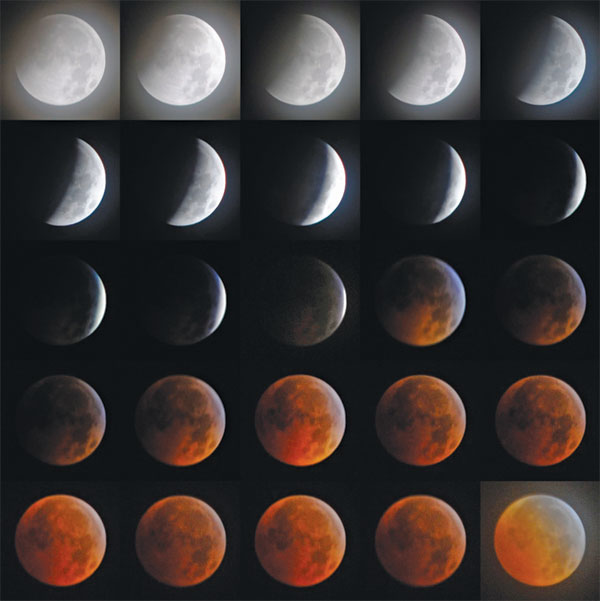
Lunar eclipses are visible from much larger geographic areas than are solar eclipses. This is due to the fact that each lunar eclipse can be viewed from the entire night hemisphere of the Earth. Unlike solar eclipses, which require special filters for eye protection except during totality, lunar eclipses are completely safe to view using the unaided eye or binoculars.
Visibility
For each type of lunar eclipse, the Moon's maximum depth into either the penumbra or umbra is characterized by a value called the eclipse magnitude. This is the fraction of the Moon's diameter immersed in the shadow. For total eclipses, the umbral eclipse magnitude is always equal to or greater than 1.0.
Penumbral eclipses can last up to 5 h. However, these events are of only academic interest since they are quite faint and difficult to see. Only the deepest penumbral eclipses (penumbral eclipse magnitude greater than 0.7) are visible to the unaided eye as a subtle shading along one edge of the Moon.
Partial eclipses are far easier to see and appear as an obvious bite or missing section along one edge of an otherwise full moon. They can last as long as 31/3 hours but are usually shorter. Partial eclipses are relatively colorless although the edge of the Earth's umbra may exhibit a reddish tinge when viewed through a telescope. The umbral eclipse magnitude of a partial eclipse is always greater than 0.0 and less than 1.0.
Total lunar eclipses have a maximum duration of nearly 21/3 hours. Their appearance is dramatically different from both penumbral and partial eclipses. When the Moon is completely immersed within the Earth's umbral shadow, it is illuminated only by indirect sunlight that has been refracted through and filtered by the Earth's atmosphere. In the process, most of the blue and green colors present in sunlight are removed. The remaining light is deep red or orange and is greatly dimmed. This gives total lunar eclipses their characteristically blood-red color, which frightened many early civilizations. If the Earth had no atmosphere, the Moon would be completely black during a total eclipse. See also: Refraction of waves; Scattering experiments (atoms and molecules)
The actual appearance of the Moon during totality can vary from one eclipse to the next. The colors range from bright orange and yellow, through various shades of red, to dark brown or gray. These visual differences are directly related to the amount of volcanic material suspended in Earth's stratosphere. Most dust and ash from volcanic eruptions rises into the troposphere where it falls back to Earth within a few days. But the sulfur dioxide gas also produced from volcanic activity combines with water vapor in the stratosphere, where it forms a high-altitude haze of sulfuric acid droplets. This haze plays a major role in determining the color and darkness of the Moon during totality. When a large amount of sulfuric acid haze is present, it has a strong filtering effect and produces a correspondingly darker eclipse. For example, the 1991 eruption of Mount Pinatubo in the Philippines pumped large amounts of sulfurous gas and ash more than 35,000 m (115,000 ft) high into the stratosphere where it was transported globally via the jet stream. Red sunsets were seen around the world, and the total lunar eclipse of December 1992 was so dark it rendered the Moon nearly invisible during totality (Fig. 9). See also: Volcano
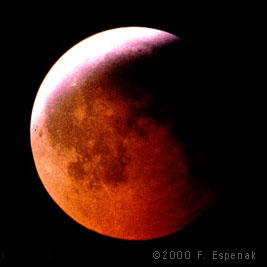
Frequency
The geometry and recurrence of lunar eclipses have much in common with solar eclipses. Lunar eclipses occur during eclipse seasons lasting about 39 days with a cycle of two seasons every 346.6 days. Lunar eclipses with similar characteristics repeat every 6585.32 days (about 18 years 111/3 days), which is the same Saros cycle described above for solar eclipses.
Every lunar eclipse is either preceded or followed by a solar eclipse within a time span of 15 days. Of course, the lunar eclipse will occur at full moon, while the solar eclipse will occur 2 weeks earlier or later at new moon. The link between lunar and solar eclipses means that there are a maximum of seven eclipses within a calendar year. They can occur in combinations of five and two, or four and three, with either solar or lunar eclipses in the majority.
In an average century, there are 241 lunar eclipses consisting of 87 penumbral, 84 partial, and 70 total eclipses. Every year has a minimum of two and a maximum of five lunar eclipses.
Future lunar eclipses
The twenty-first century will have 228 eclipses of the Moon, consisting of 86 penumbral, 57 partial, and 85 total eclipses. During this epoch, 78 years will have 2 lunar eclipses each, 16 years will have 3 eclipses, and 4 years will have 4 eclipses. No year contains more than 4 eclipses. The last time 5 lunar eclipses occurred during one calendar year was 1879, and the next will be 2132.
During the 25-year period 2011 through 2035, there will be 23 total eclipses of the Moon (Table 2). Deep eclipses have large magnitudes and long durations (for example, June 15, 2011; July 27, 2018; and June 26, 2029).
|
Date† |
Umbral magnitude |
Duration of totality |
Geographic region of eclipse visibility |
|---|---|---|---|
|
June 15, 2011 |
1.705 |
1 h 41 min |
South America, Europe, Africa, Asia, Australia |
|
Dec. 10, 2011 |
1.110 |
0 h 52 min |
Europe, Eastern Africa, Asia, Australia, Pacific, North America |
|
Apr. 15, 2014 |
1.291 |
1 h 18 min |
Australia, Pacific, Americas |
|
Oct. 8, 2014 |
1.166 |
0 h 59 min |
Asia, Australia, Pacific, Americas |
|
Apr. 4, 2015 |
1.001 |
0 h 05 min |
Asia, Australia, Pacific, Americas |
|
Sept. 28, 2015 |
1.276 |
1 h 12 min |
Eastern Pacific, Americas, Europe, Africa, western Asia |
|
Jan. 31, 2018 |
1.315 |
1 h 16 min |
Asia, Australia, Pacific, western North America |
|
July 27, 2018 |
1.609 |
1 h 43 min |
South America, Europe, Africa, Asia, Australia |
|
Jan. 21, 2019 |
1.195 |
1 h 02 min |
Central Pacific, Americas, Europe, Africa |
|
May 26, 2021 |
1.009 |
0 h 15 min |
Eastern Asia, Australia, Pacific, Americas |
|
May 16, 2022 |
1.414 |
1 h 25 min |
Americas, Europe, Africa |
|
Nov. 8, 2022 |
1.359 |
1 h 25 min |
Asia, Australia, Pacific, Americas |
|
Mar. 14, 2025 |
1.178 |
1 h 05 min |
Pacific, Americas, western Europe, western Africa |
|
Sept. 7, 2025 |
1.362 |
1 h 22 min |
Europe, Africa, Asia, Australia |
|
Mar. 3, 2026 |
1.151 |
0 h 58 min |
Eastern Asia, Australia, Pacific, Americas |
|
Dec. 31, 2028 |
1.246 |
1 h 11 min |
Europe, Africa, Asia, Australia, Pacific |
|
Jun. 26, 2029 |
1.844 |
1 h 42 min |
Americas, Europe, Africa, Mid East |
|
Dec. 20, 2029 |
1.117 |
0 h 54 min |
Americas, Europe, Africa, Asia |
|
Apr. 25, 2032 |
1.191 |
1 h 06 min |
Eastern Africa, Asia, Australia, Pacific |
|
Oct. 18, 2032 |
1.103 |
0 h 47 min |
Europe, Africa, Asia, Australia |
|
Apr. 14, 2033 |
1.094 |
1 h 19 min |
Europe, Africa, Asia, Australia |
|
Oct. 08, 2033 |
1.350 |
1 h 00 min |
Asia, Australia, Pacific, Americas |
*Data courtesy of Fred Espenak, http://eclipse.gsfc.nasa.gov/eclipse.html.
†Date of mid-eclipse (Greenwich Mean Time).





